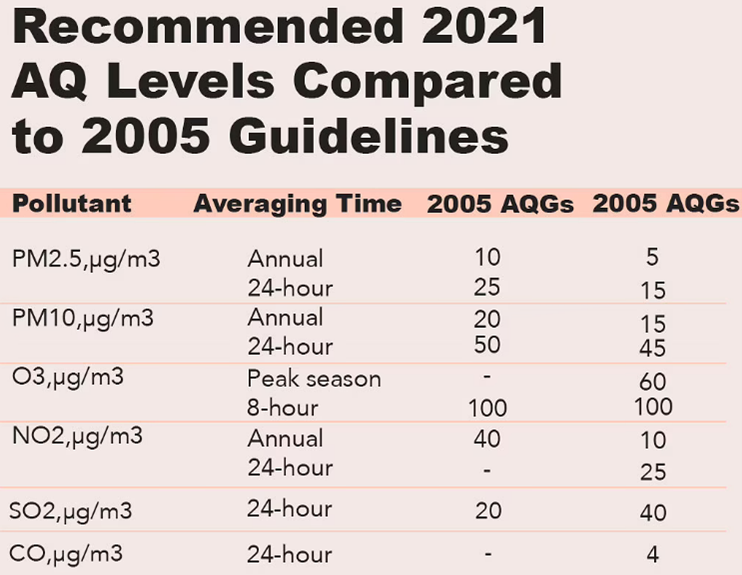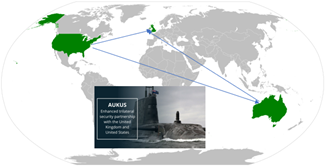Thursday, 9th September 2021
Carbon Sequestration - Edukemy Current Affairs
In News
A company from Iceland has built the world's largest Carbon Sequestration plant.
About the news
- The plant named Orca, meaning energy, can draw 4,000 tonnes of carbon dioxide (CO2) out of the air every year, which is equivalent of annual emissions of about 870 cars.
- Direct air capture is one of the few technologies extracting carbon dioxide from the atmosphere.
- There are currently 15 direct air capture plants operating worldwide, capturing more than 9,000 tonnes of CO2 per year, according to the IEA.
- However, the technologies are still expensive and might take decades to operate at scale. There is also uncertainty with respect to long term storage capacity.
What is Carbon Sequestration or Carbon Capture?
- Carbon sequestration / Carbon Capture and Storage (CCS) is the process of capturing and storing atmospheric carbon dioxide. It is one method of reducing the amount of carbon dioxide in the atmosphere with the goal of reducing global climate change.
- Direct air capture is one such technology to capture CO2 from the atmosphere. Through this method, CO2 can be permanently stored in deep geological formations.
Benefits of Carbon Sequestration
- Aids Climate change mitigation: These technologies have the ability to reduce the amount of CO2 that is already in the air. These technologies can become a major tool in the fight against climate change.
- Reduces the Social Cost of Carbon: It can reduce the social cost of carbon, which is the estimated costs and benefits to society from climate change caused by one additional metric ton of CO2 released into the atmosphere in a year.
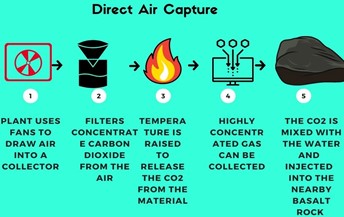
Source :
Safe City Index 2021
In News
Recently, the fourth edition of the Safe City Index was released by The Economist Intelligence Unit and NEC Corporation.
About the News
- The fourth iteration of the Safe City Index looks at 60 cities across 76 indicators, covering digital, health, infrastructure, personal, and - new this year - environmental security.
- Overall Ranking: The top 5 cities were Copenhagen, Toronto, Singapore, Sydney, Tokyo, in that order.
- With a score of 56.1 and 54.4, respectively, New Delhi and Mumbai ranked among the first 50 on the global Safe Cities Index 2021,
- Yangon (Myanmar) is at the bottom of the index with a score of 39.5 being considered as the least safe city.
- Parameter-wise ranking
- Personal security: New Delhi ranked 41st (52.8) while Mumbai ranked 50th (48.2).
- Health security: Mumbai (44th) lagged New Delhi (40th)
- Infrastructure security: New Delhi ranked 44th, while Mumbai ranked 48th
- Environmental security: New Delhi (49th) lagged Mumbai (46th)
About the Safe City Index
- About: The Safe Cities Index was first launched in 2015 with 44 indicators and 50 cities. Since then, the index has been updated once every two years, increasing city coverage as well as strengthening the framework to include emerging challenges to urban safety.
- In 2021, the framework has been further updated to reflect the dynamic nature of the urban safety landscape with a special focus on the pandemic impact. It has also introduced a brand new pillar: environmental security.
- Indicators: The Safe Cities Index is a global, policy benchmarking tool developed to measure urban safety. The index score draws on 76 distinct factors across five broad pillars: personal, infrastructure, health, digital and environmental security.
- The outputs measure how safe a city currently is, while the inputs indicate which cities are doing the right things to enhance security.
- Scale to measure: It is from 0-100 where 0-25 indicates Low Safety, 25.1- 50 (Medium Safety) 50.1- 75 (High Safety) and 75.1-100 (Very High Safety)

Sources:
Heat wave prone regions in India
In News
A recent study has revealed three new heat wave hotspots in India, which puts India’s large population at immediate health risk.
About the News
- A heat wave is a period of abnormally hot weather generally lasting more than two days. Heat waves can occur with or without high humidity. They have potential to cover a large area, exposing a high number of people to hazardous heat.
- The study links the association of Heat Wave (HW) and Severe Heat Wave (SHW) with mortality over India.
- The study focused on spatial and temporal trends in HW & SHW over the past seven decades in different meteorological subdivisions of India.
Highlights of the Study
- Heat wave- a deadly Hazard Heat waves emerged as a deadly health hazard, claiming thousands of lives both across the globe and in India over the past half century.
- There have been episodes of strengthening in frequency, intensity, and duration causing severe impacts on health, agriculture, economy, and infrastructure.
- Three New Hotspots: North-Western, Central, and south-central region of India are the new hotspot of intense heat wave events in recent decades.
- Shift in Trends: The study showed a shift in the Spatio-temporal trend of HW events from the eastern region of Gangetic West Bengal and Bihar to North-Western, Central and further to south-central region of India.
- Regions already with Low DTR faced with heat stress: There has been an alarming southward expansion and a spatial surge in SHW events that may put a greater population at additional risk of heat stress in a region already characterized by low DTR and high humidity.
- Diurnal temperature range (DTR) is the difference between the maximum and minimum temperatures within one day.
- The HW/SHW events were found to be positively correlated with mortality in Odisha and Andhra Pradesh, highlighting that human health is highly susceptible to severe heatwave disasters.
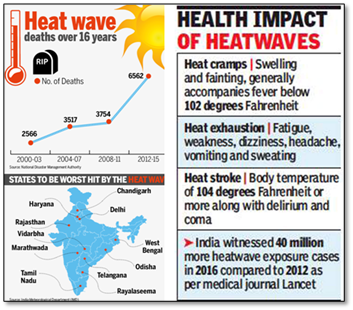
Source:
- Study identifies three prominent heatwave prone regions in India:
- Three new heatwave hotspots in India put large population at immediate health risk: Study:
- Three new heatwave hotspots emerge in India, huge population at risk: Study:
- Heatwave deaths on rise
- Heatwave conditions prevail across Telengana, heat illness cases climb to 254
India’s Approach to Refugees
In News
As Afghanistan reels under the final onslaught of the Taliban, the crippling refugee crisis is gaining traction.
About the News
- As the Taliban began overrunning the Afghan countryside early this year, hundreds of thousands were forced to flee to provincial capitals and the national capital, Kabul.
- India has expressed concern for Afghani citizens at the UNSC, but did not steer the Council’s agenda towards creating pathways for Afghan refugees and focused entirely instead on New Delhi’s fears of potential terrorism in the neighbourhood.
- India has been a traditional destination for refugees from Afghanistan over the past 30 years. The three main waves of refugees arrived during the Soviet-Afghan war (1979-1989), the Afghan Civil War (1992-96) and during the Taliban rule (1996-2001).
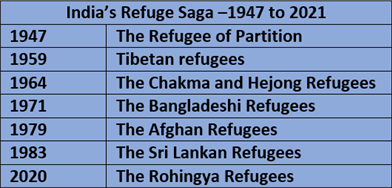
Who is a Refugee?
- Refugee: Under the 1951 UN Convention on the Status of Refugees and the subsequent 1967 Protocol, the word refugee pertains to any person who is outside their country of origin and unable or unwilling to return owing to well-founded fear of persecution for reasons of race, religion, nationality, membership of a particular social group or political opinion.
- Asylum-seeker: An asylum-seeker is a person who has left their country and is seeking protection from persecution and serious human rights violations in another country, but who hasn’t yet been legally recognized as a refugee and is waiting to receive a decision on their asylum claim. Seeking asylum is a human right. This means everyone should be allowed to enter another country to seek asylum.
- Migrant: There is no internationally accepted legal definition of a migrant. Some migrants leave their country because they want to work, study or join family, for example. Others feel they must leave because of poverty, political unrest, gang violence, natural disasters or other serious circumstances that exist there.
India’s Status w.r.t. Refugees
- 1951 UN Refugee Convention: Despite hosting refugees from across Tibet, Bangladesh, and beyond for generations, India is not a signatory India is not a signatory to the 1951 Convention on Refugees or the 1967 Protocol Relating to the Status of Refugees.
- No Refugee Policy: Unlike other nations such as the United States, European Union, India has no official refugee policy. Though, there are some laws that govern refugees, including the Registration of Foreigners Act, 1939; Foreigners Act, 1946, and the Passport Act, 1967.
- Citizenship Act, 2019: This Act, aims to facilitate grant of citizenship to migrants belonging to Hindu, Sikh, Buddhist, Jain, Parsi and Christian communities from Afghanistan, Pakistan and Bangladesh who have taken shelter in India due to persecution on grounds of religion or fear of such persecution on or before December 31, 2014.
- Strategic ambiguity: India’s asylum policy is regarded as “strategic ambiguity.” It seems to be a policy which on the one hand embodies the principle of ‘Vasudeva Kutumbakam’ and welcomed Tibetan refugees and Tamil refugees from Sri Lanka, providing them with shelter and support but seems to be averse to the prospect of safety and security of those fleeing from other countries, like the Rohingya from Myanmar.
Why do Refugees need to be accepted and supported?
- Humanitarian Needs: The earlier a state commits to protecting refugees, the earlier they can move forward with their lives, without uncertainty blocking the way. Most importantly, accepting them protects the most precious right of all, i.e. the right to live.
- Moral Responsibility: Protection of refugees is simply a responsibility entailing restoration of the most basic of rights to the people affected. Not least the right to life, to not suffer torture or discrimination, to ensure respect for one’s human dignity and safety of one’s family.
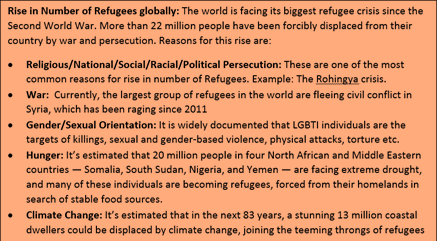
- Benefits to the Host Communities: Host communities benefit from the tremendous energy and drive to start new lives, which refugees bring. Some of the most inspiring and influential people in the arts, science, politics and technology have been refugees, asylum-seekers and migrants.
- Globalised World: Refugees are a vulnerable group and exposed to limited material and financial resources. Their family and community structures are strained or destroyed. This may transform into extremist tendencies and become a global threat.
What are factors that deter the acceptance of Refugees in India?
- Internal Security Fear: The reluctance to accept or non-acceptance of refugees has its roots in the fear internal security, emanating from the possibility of community conflicts, refugees indulging in extremist or illegal activities and also the possibility of harassment and atrocities to refugees.
- Ad-hoc Refugee Policy: India is one of the few liberal democracies that is not a party to the 1951 UN Refugee Convention and its 1967 Protocol, nor does it have a domestic refugee law. Since Indian law does not define who is a refugee, the government can brand all refugees and asylum seekers under the umbrella “illegal migrant” term.
- Economic and political strain: India’s birth as a nation was followed by a large-scale and violent mass movement of people to and from Pakistan during the Partition. So, there lies the fear of the economic and political strain that the rehabilitation and resettlement of refugees holds and the obligations under the global refugee regime.
Way Forward
- Legislation on Refugees: A clear legislation on refugees would provide for a rights-based approach rather than a charity-based approach. Legislation would allow the country to prevent refoulement and arbitrary detention of refugees.
- Additionally, a clear law with clear definitions of a ‘migrant’ and a ‘refugee’ will also help identify actual ‘illegal immigrants’, ensuring the security and safety of the country without breaching international law.
- Accede to the 1951 UN Refugee Convention: With this, India could take advantage of the expertise of the UNHCR with regards to Refugee Status Determination and collaboratively work on the socio-economic protection of refugees, thereby reducing the financial and administrative burden on the state’s exchequers.
Conclusion: In order to lead global refugee crisis, India must shed its ad hoc approach to refugee crises and immediately lay out a refugee law, introducing objectivity and inclusivity into its policy. At the UNSC, India should lobby countries around the world to resettle innocent men, women and children fleeing from the violence. There is no better way for New Delhi to demonstrate timely leadership on this unfolding global security crisis.
Question: Discuss the approach of India towards refugees over the years. What change is needed in the approach in the times of growing refugee crisis?
Sources:
- India Must Champion the Cause of Afghan Refugees More Inclusively:
- Explained | Where does India stand on Afghan refugees fleeing the Taliban?:
- NRC row: Where does India stand on refugees?:
- Explained: On ‘refugees’ and ‘illegal immigrants’, how India’s stance changes with circumstances:
- Why India is home to millions of refugees but doesn’t have a policy for them:
- Indian Refugee Policy: From Strategic Ambiguity to Exclusion?:
- Refoulement, Rohingya and a Refugee Policy for India:
- India does have a refugee problem
- REFUGEES, ASYLUM-SEEKERS AND MIGRANTS
- 5 Of The Biggest Reasons Why People Become Refugees:
- India's refugee saga, from 1947 to 2017:
Mao Zedong
On September 9, 1976 Marxist revolutionary Mao Zedong died. Mao Zedong (born December 26, 1893, China) was the principal Chinese Marxist theorist, soldier, and statesman who led his country’s communist revolution. Mao was the leader of the Chinese Communist Party (CCP) from 1935 until his death, and was chairman (chief of state) of the People’s Republic of China from 1949 to 1959 and chairman of the party also until his death. He was both a product and a part of the revolutionary change in 20th-century China.

Source:
Fogging
This is the image of the fogging process, which is being carried out curb the growth of mosquitos by spraying anti-larval medicines. Thermal fogging is the process by which disinfectant solution is suspended within the air for a period of time in order to disinfect the surfaces of dust particles and inaccessible parts of a building. It is the last, but most important, stage of any complete biosecurity cleaning and disinfection programme, playing a major role in disease prevention and control.
Sources:
Thermal Fogging Disinfection: https://lanxess.com/en/Products-and Solutions/Brands/Virkon/Biosecurity-Disinfectants/Hyperox/Thermal-Fogging-Disinfection
Kudubi Community
- Context: The Chairman of the State Backward Classes Commission has insisted that the Kudubi community deserved the Scheduled Tribes status.
- Kudubi is a tribal community living in remote villages across Dakshina Kannada and Udupi districtsof Karnataka and are original inhabitants of Goa region.
- They are socially and economically backward community who have the least access to educational & medical facilities and exposure to modernization.
- Gummat (men wearing traditional costumes dance playing Gummat-a percussion instrument) and Kolata (men in costumes dance with sticks in hands) are two cultural dances of the community performed to tunes of songs that narrate Ramayana, Mahabharata, Shivapurana and other epics during the festival.
- Vanabhojana (celebrated on riverside where fishing is a part of the tradition), Mahammayi pooja and Mahalaya (respect paid to ancestors by offering them food) are other important occasions of the community.
- The Kudubis are known for their knowledge on traditional medicine.

Source:
- Kudubis deserve ST status, says Hegde
- A community rooted in its roots
- Kudubi community should get ST tag, says study
Image source:
Submerged Aquatic Plants
- Context: Submerged aquatic weeds have been posing a new threat to the paddy cultivation in districts of Kerala.
- The weeds that pose a threat include aquatic plants like:
- Vallisneria (eel grass or tape grass) introduced as an ornamental aquarium plant.
- Najas (rice field water-nymph) found in freshwater habitats, especially still or slow-moving waters, like ponds and in rice fields.
- Utricularia, a carnivorous aquatic plant common in rice fields.
- Reasons for threat
- The problem of these weeds is severe in transplanted crops where they get the ideal condition of a standing water column and sufficient inter-space and sunlight.
- Absence of other common rice weeds at this stage and fertilizers applied to the crop become totally ineffective as these weeds absorb the nutrients forming a thick mat over the soil.
- With hand weeding being practiced in many regions, it is difficult to control its spread.
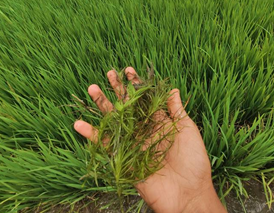
Source:
Image source:
Nipah Virus - Edukemy Current Affairs
- Context: There has been a rampant increase in the number of Nipah virus cases in Kerala.
- Nipah virus is a zoonotic virus caused by fruit bats.
- It is transmitted via animals to humans and can also be transmitted through contaminated food or directly between people. It is fatal to both humans and animals.
- There is no definite line of treatment available for this virus.
- Nipah virus was first recognized in 1999 during an outbreak among pig farmers in, Malaysia.
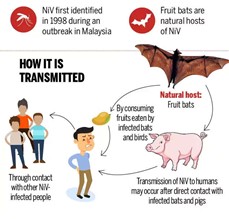
Source:
Image source:
Corbett National Park
- Context: National Tiger Conservation Authority (NTCA) has asked the officials to investigate the allegations of tree felling, illegal construction of bridges and walls in Corbett Tiger Reserve.
- Jim Corbett National Park in the Nainital district of Uttarakhand along the Ramganga River at the foot of the Kumaon Hills.
- It comprises of hills, marshy depressions, riverine belts, grasslands and large lakes.
- It is India's oldest National Park and Project Tiger was first launched here in 1973.
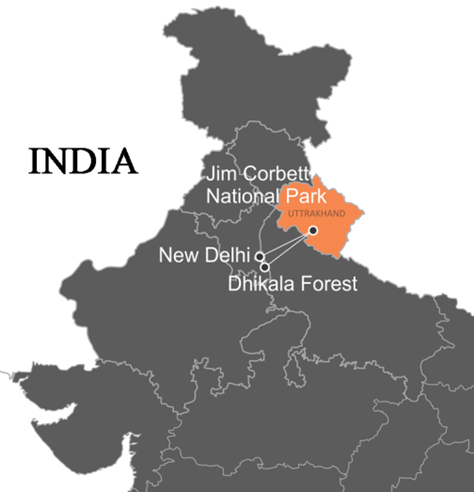
Source:
Image source:
Twenty years later, a fractured world
Essence: The article talks about the geopolitical contestations taking place in Afghanistan post-9/11. The political takeover of Kabul by the Taliban and invitation being sent to six countries- Pakistan, China, Russia, Qatar, Turkey, and Iran for being part of the formation of Taliban-led government in Afghanistan best symbolized the geopolitical repercussions of the post-9/11 era. Concatenation of four regional geopolitical contests across the Eurasian landmass have been affected by recent political upheaval in Afghanistan. The Taliban takeover has made variables like China’s more active presence in the Indian Ocean, the India-Pakistan rivalry, and Turkey’s activism more blur. The article mentions the growing threat of terrorism stemming from Taliban-led Afghanistan for India and across the globe. Why you should read this article? To understand the geopolitical turnover taking place due to the Taliban takeover of Afghanistan. To understand the dynamics and variables which remain constants and which may get affected by the Taliban takeover. Twenty years later, a fractured world
The impossible task of taming the rupee- HBL
Essence: With central banks of US, ECB and Japan continuing to follow easy monetary policy, gush of foreign fund flow in form of FDI and FII in Indian market is strengthening rupee vis-a-vis dollar. Article points out that having learnt lessons from its previous market interventions, RBI is reluctant to take steps to weaken rupee which might have helped exporters. While acknowledging the dilemma being faced by the RBI, author prescribes that it is best for RBI to keep hands off as it will keep inflation in check by keeping liquidity low and reducing price of imported goods. Why should you read this article? To get familiar with some monetary policy tools available with RBI. To appreciate how increasing integration of Indian market with global market, while creating opportunities for growth, also makes policy choices complex for regulators
How India’s food systems must respond to the climate crisis- IE
Essence: The UN Secretary General is convening the Food Systems Summit which aims to transform global food systems to achieve Sustainable Development Goals. Though India became a food surplus country, the policies are still based on the deficit conditions of 1960s. These policies need to be changed to transform our food systems to be more diversified, high-value production and better remunerative prices so that our agriculture sector is more inclusive, nutrition sensitive and sustainable. Changes in food systems need to be supplemented with health infrastructure, strong social protection and robust non-agriculture sector.
Why you should read this article:
- To know the definition of food systems, importance of transforming them and the action tracks to achieve this transformation.
- To understand the Indian food systems policies and its effects.
- To understand the type of new food systems we want and the measures to be taken.
Source:
Haryana: A Sports Nursery
Background
- India recorded its best performance and won 7 medals in Olympics 2021 and 19 medals in the Paralympics 2021.
- Haryana alone accounted for nine of these medals across the two competitions which is about one-third of the total medals.
How is Haryana creating a sports nursery?
- Greater grassroots support: Most of the Haryana athletes are from financially weaker section, the State Government equips them with financial aid and job security to focus better.
- Raw natural talent: The natural sport environment gives a better ecosystem for them to develop capacity for sport.
Champions emerging from newer sports: Apart from traditional sports like wrestling and hockey, other sports such as javelin and shooting are also given importance.
Lessons to be learned
- As most of the sportsperson in the country are from humble background, there is a need to provide better financial assistance.
- Inculcating a natural environment for the children to understand their core interest in sports rather than forcing them to imbibe the traditional ones.
Quote: “One man practicing sportsmanship is far better than 50 preaching it.” Knute Rockne
Where can it be used:
Paper 2: Government Policies and Interventions for Development in various sectors and Issues arising out of their Design and Implementation.
Source:
Share the article
Get Latest Updates on Offers, Event dates, and free Mentorship sessions.

Get in touch with our Expert Academic Counsellors 👋
FAQs
UPSC Daily Current Affairs focuses on learning current events on a daily basis. An aspirant needs to study regular and updated information about current events, news, and relevant topics that are important for UPSC aspirants. It covers national and international affairs, government policies, socio-economic issues, science and technology advancements, and more.
UPSC Daily Current Affairs provides aspirants with a concise and comprehensive overview of the latest happenings and developments across various fields. It helps aspirants stay updated with current affairs and provides them with valuable insights and analysis, which are essential for answering questions in the UPSC examinations. It enhances their knowledge, analytical skills, and ability to connect current affairs with the UPSC syllabus.
UPSC Daily Current Affairs covers a wide range of topics, including politics, economics, science and technology, environment, social issues, governance, international relations, and more. It offers news summaries, in-depth analyses, editorials, opinion pieces, and relevant study materials. It also provides practice questions and quizzes to help aspirants test their understanding of current affairs.
Edukemy's UPSC Daily Current Affairs can be accessed through:
- UPSC Daily Current Affairs can be accessed through Current Affairs tab at the top of the Main Page of Edukemy.
- Edukemy Mobile app: The Daily Current Affairs can also be access through Edukemy Mobile App.
- Social media: Follow Edukemy’s official social media accounts or pages that provide UPSC Daily Current Affairs updates, including Facebook, Twitter, or Telegram channels.

